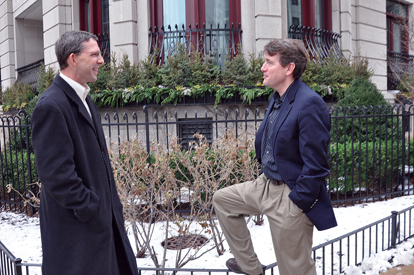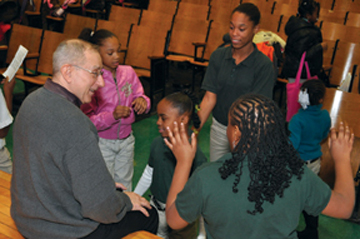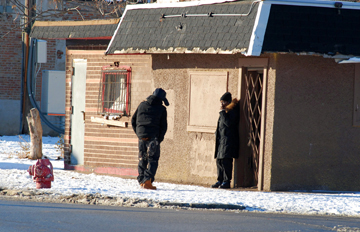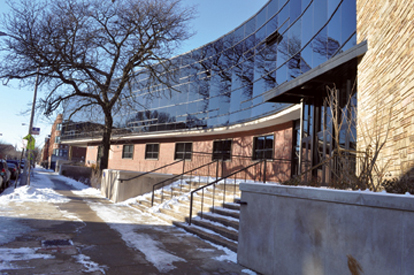Podcast: Peter Meyer reports from Chicago, where two public schools have been launched by a Roman Catholic religious order.
Additional photographs of the Catalyst Schools are available here.
Train a child in the way he should go, and when he is old he will not turn from it.
—Proverbs 22:6
It wasn’t exactly a marriage made in heaven. In fact, the idea that one of the Catholic Church’s most respected religious orders might run a public school sounded odd, maybe even, as Francis Cardinal George, head of the Archdiocese of Chicago, conjectured, illegal.
But a decade ago several trends in American education, and in the Catholic Church, made a Catholic-operated public school seem increasingly possible: 1) the traditional, parish-based Catholic school system, especially in the inner cities, was crumbling; 2) equally troubled urban public-school systems were failing to educate most of their students; and 3) a burgeoning charter school movement, born in the early 1990s, was beginning to turn heads among educators in both the private and public sectors.
The various currents merged in the Windy City in 2006 and 2007 when the Christian Brothers helped open two charter schools in impoverished neighborhoods on Chicago’s west side, embarking on a unique experiment in public education. Could Catholics run a school without mentioning Jesus, Mary, or Joseph? Without prayer, Mass, the rosary, the sacraments? Without God? And could the high wall between church and state be kept intact?
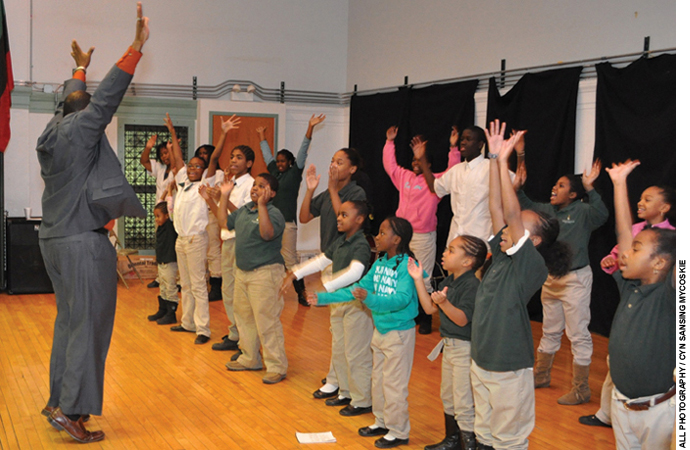
Back to Their Roots
The Christian Brothers—known in France, where the Catholic order was founded in 1680, as Frères des écoles chrétiennes or Brothers of the Christian Schools—have had some experience in education. The order’s founder, Jean-Baptist de La Salle, is the church’s patron saint of teachers and today the order serves nearly 1 million students in more than 80 countries, including some 20,000, mostly middle-class, students in 90 Catholic middle and high schools and education centers in the United States.
But what caught the eye of Arne Duncan, while he directed Chicago Public Schools (CPS), was the success the brothers were having with an initiative the order had launched in the early 1990s. They had opened San Miguel schools, named after a Christian Brother saint from Ecuador, in American pockets of poverty, including an Indian reservation in Montana, the Tenderloin district of San Francisco, and inner-city Camden, New Jersey. (In 2006 San Miguel merged with the Jesuits’ Nativity Schools; today the NativityMiguel Network operates over 70 schools for the poor in 26 states and the District of Columbia.)
The first Chicago San Miguel school opened in 1995, behind the infamous (now gone) stockyards. The goal was simple enough: bring to poor children, tuition-free, what the brothers were delivering to middle- and upper-class students in their other American schools, including small class sizes and a college-prep academic program.
It worked. Within a few years of opening, San Miguel Back of the Yards School’s low-income students were outperforming their Chicago Public Schools counterparts. The school’s success prompted Lands’ End company founder Gary Comer to donate $1.2 million to open a second school, now known as the Gary Comer Campus, in the blighted Austin neighborhood.
The schools employ a year-round academic calendar, have a 9:1 student-to-teacher ratio, and a core academic curriculum. They put heavy emphasis on reading—80 minutes a day, an average of 165 books read per year—and individualized instruction.
“Our model is not rocket science,” says Mike Anderer-McClelland, a former brother who is now president of the San Miguel organization in Chicago. “It is a lot of reading, writing, and arithmetic.”
The schools also have a Family and Graduate Support Program that not only tracks students through high school but helps them and their parents with tutoring and counseling, long after they leave left San Miguel at the end of 8th grade.
“We graduate 85 percent of our kids from high school in a neighborhood that traditionally graduates less than 40 percent,” says Anderer-McClelland. “Sixteen percent of our kids graduate from four-year colleges, compared to less than 5 percent of public school kids in our neighborhoods; and it’s only 3 percent of CPS Latinos and 4 percent of CPS blacks who graduate from college.”
Getting from No to Yes
A faith-based or church-sponsored charter school had been the subject of some discussion among Catholics in Chicago almost from the moment that Illinois passed a charter school law in 1996. Though the law initially allowed just 20 charters statewide, 15 of the slots were assigned to Chicago.
Coincidentally, the Archdiocese of Chicago, which ran the nation’s largest parochial school system with more than 130,000 students, was in the midst of a demographic and financial crisis. The archdiocese had closed 55 of its schools in the previous 10 years. (See my story, “Can Catholic Schools Be Saved?” features, Spring 2007.) At the time, CPS CEO Paul Vallas and others encouraged the church to consider converting their closed and closing schools to charters. But in 1999 Cardinal George said “No.” It was “a square circle,” he remarked, “not because of archdiocesan protocols but because of the nature of the beast.”
That view was shared by others, including the National Catholic Educational Association (NCEA). “Are charter schools another way to keep Catholic schools alive, as some proponents suggest?” the NCEA asked in a 2009 press release. “Absolutely not.”
Catholic leaders could not support schools that were not grounded in religious instruction.
However, in what was perhaps an unintended consequence of the church’s crisis, a former priest became one of the first to open a public charter school in Chicago. John Horan, director of the Archdiocese’s Catholic Youth Organization when he was a priest, opened the public North Lawndale College Prep charter in 1998 as a layperson. “Catholic schools were terrific,” says Horan today, “but there just wasn’t enough financial support to send all of our poor kids to Catholic schools. So we thought, we…have to make public schools work.”
This is what Paul Vallas and Arne Duncan were thinking, too. Vallas had floated the idea of the Christian Brothers running a public school as early as 1997, recalls Ed Siderewicz, a young Christian Brother who helped start the San Miguel Back of the Yards School, “but we shrugged it off as compromising our mission.”
The question would keep coming up.
“The [San Miguel] board really wrestled with this,” recalls Sister Margaret Farley, director of personnel for the archdiocesan schools of Chicago and a founding board member of San Miguel. “We thought we could do a values-based school, but many members of the board were superparanoid about anyone thinking it would be a Catholic school.”
Early on in the discussions, Brother Gordon Hannon, a Chicago native and cofounder of San Miguel Back of the Yards School, researched the question in a paper for a graduate course at DePaul University. He concluded that though the San Miguel model “meets a clear and urgent secular need,” it was an open question whether “a faith-based group of competent, licensed educators” could run a publicly funded school without crossing the church/state line.
Brother Mike Fehrenbach, head of the Christian Brothers’ Midwest District, saw an opening in the “values-based” charter idea (instead of faith- or religious-based) and convinced the San Miguel board that the question was worth exploring. And in July of 2004 they formed a special charter-school planning committee.
Money was a significant consideration.
“We are probably near the limit of our ability to raise the dollars necessary to expand effectively,” wrote Fehrenbach in a one-page memo to the group, referring to the cost of running the two private San Miguel schools. He suggested that a charter school, which was publicly financed, might be a way of bringing education to the poor without having to spend so much time fundraising.
“This sounded like a growth company,” smiled Terry Toth, recalling his initial reaction to the idea. Toth, a lifelong Catholic, was a member of the San Miguel board as well as head of the world’s 12th largest investment bank, Northern Trust. “We would get 85 percent of our costs paid for—versus the need to fundraise 100 percent,” he laughs. “Win-win.” Toth also recognized that it was an opportunity to have an impact on more people. “Obviously, there was a church/state issue. But it was worth trying.”
“We Can Do This”
That is what Arne Duncan said, Ed Siderewicz recalls, when Gary Comer brought him to visit the San Miguel Austin campus in 2004. “You get your team behind it and I’ll make it work.”
“We asked a few questions,” recalls Siderewicz, “but I remember thinking that if our starting point is how to make it work rather than what we have to give up, then we should continue talking.”
And they did continue talking, with more and more detailed attention given to the question of San Miguel’s core mission. God or no God? For his part, Mike Fehrenbach didn’t see the charter undertaking as a challenge to the brothers’ mission, which he believed was “about offering people an opportunity for a future worth living.” They could do this by exemplifying Christian and Catholic values; they didn’t have to preach them. (This was not unknown territory for the Christian Brothers. In many countries they ran secular schools; in Indonesia, in fact, they operated a Muslim school.)
At the end of January 2005, the order’s district council voted to launch the charter school. And a month later, Brother John Johnston, then the order’s Superior General in Rome, weighed in: he saw “no important reasons for saying no” and “important reasons why we should say yes.”
Too Good to Be True
But the Christian Brothers were suddenly given another challenge. In the middle of writing the application for the charter school they wanted to open, Arne Duncan asked them to take over a public school he was closing in the North Lawndale neighborhood. This was part of the “turnaround” strategy that Duncan initiated in Chicago and would bring to his job as secretary of education in the Obama administration: improve some schools by closing them, then reopening under new management.
This was fine except that the brothers had already found the neighborhood for their new charter school: Austin, near the Gary Comer Campus San Miguel School. Austin was clearly needy; it had the highest number of homicides in Chicago in 2003 and nearly 30 percent of families with children under 18 lived in poverty. The neighborhood high school had the second-highest dropout rate in the state of Illinois. And the brothers had good connections in Austin, including with Circle Urban Ministries and the Rock of Our Salvation Church, an active evangelical Baptist congregation that owned a former Catholic school there.
“It was like manna from heaven,” recalls Rev. Abraham Lincoln Washington, pastor of the congregation, remembering Brother Ed Siderewicz’s request to open a charter school in his facility. Circle Rock had been struggling to keep open its 185-student religious school for the poor. “We had a vacant building and they had 300 years of experience educating kids.”
Reverend Washington’s congregation was also a strong one, providing a rich mix of social services, including a food pantry, legal and medical services, transitional housing, and education. “Education is like preventive medicine,” he says. “It’s so important.”
But the perfect union between Christian Brothers and Baptists would have to wait.
“At the last moment, Duncan asked us to take over the Howland School in North Lawndale,” recalls Siderewicz, “before we opened Austin Circle Rock. Naively, we said ‘Okay.’”
Although the neighborhoods are, technically, adjacent, Austin and North Lawndale are among Chicago’s largest neighborhoods and so the Howland School was more than five miles south of Austin Circle Rock—a world away. Especially for the Christian Brothers, who had no presence there.
Worse, North Lawndale was even needier than Austin. At the time of the 2000 U.S. Census, approximately 10,000 adult males from the neighborhood were in prison. Says Father Lawrence Dowling, pastor of St. Agatha Parish, which is just four blocks from the Howland School, “We have the highest incidence of HIV in the state, the highest rate of asthma for kids in the state, and the highest percentage of grandparents raising grandchildren in the nation.”
“As poor a census tract as you can find,” says John Horan, who had established his North Lawndale charter high school in one part of the sprawling Howland building. “Do I know the neighborhood?” he chuckles. “I am completely grey because of it.”
But the Christian Brothers didn’t know the neighborhood, and the neighborhood didn’t know them. Recalls Fehrenbach, “The community was in an uproar over the closing of their school—and then we came in.”
At an initial public meeting, a group calling itself “The Voice of the ExCon” sent dozens of people, who shouted and screamed. “It was a bit scary,” recalled Siderewicz. “But we made it through.”
The Christian Brothers eventually won the group over by giving them a tour of their San Miguel schools, but the initial animosity was a sign of things to come.
A Tale of Two Schools
The brothers opened Howland Catalyst Charter School, on schedule, in the fall of 2006 and Austin’s Circle Rock Catalyst in 2007. The Howland plan called for starting with 4th and 5th grades, with two classes of 15 students in each grade; it would add 3rd and 6th grades in year two, 2nd and 7th grades in year three, 1st and 8th grades in year four, and kindergarten in year five, growing to 540 students in grades K through 8 by 2010. The Austin plan was to start with 5th and 6th grades beginning in 2007, add 7th and 8th grades in the second year, then build up from kindergarten to 4th grade in the next two years.
Both plans reflected the brothers’ belief in the importance of middle school, which was the focus of their San Miguel initiative. And true to the San Miguel model, they brought to the Catalyst charters their 9:1 student-to-teacher ratio, a belief in academic excellence, graduate and family support, and the goal of having every child reading at or above grade level before graduation (8th grade). They also brought modern assessment tools, including standardized testing several times a year, teacher-designed testing on a weekly basis, nightly homework that was checked each day by the teacher, and daily testing/assessment in core subject areas.
Despite the model, the polished floors, new banners, and students outfitted in spiffy olive and khaki uniforms, the staff at Howland was quickly overwhelmed by the outsized needs of its student population, which was 100 percent African American and 98 percent eligible for free or reduced-price lunch.
“These children live in a world where you can’t appear weak—it can be deadly,” says assistant principal Igbazenda Moses, a Nigerian native and former Christian Brother who came to Chicago in 2002 and joined the Catalyst staff in 2006. “All of this makes the kids very uptight and creates a huge barrier to learning.”
Howland’s was a student population suffering from enormous environmental, economic, and social trauma—a kind of permanent Post-Traumatic Stress Disorder.
“Three weeks ago we had a child whose dad was shot and killed,” Moses says. “We have two kids like that here now. There is so much violence in their daily lives. They hit you—and they’re used to getting hit back. Self-control is a big issue for these kids.”
Howland’s leaders were caught off guard by the severity of the social and environmental ills, and the effort it would take to address them. As Brother Ed Siderewicz recalls, “We had every problem in the book and more. I had forgotten how hard it was to start a school.”
God Help Us!
Assistant Principal Moses believes that the inability to teach religion was a significant part of the problem. “Talking about how to be respectful and trustworthy is not the same as talking about a person’s life being grounded in the knowledge of God,” he says. “And that’s what these children and their families need. ‘Character Counts’ just doesn’t do the trick.”
Brother Mike Fehrenbach smiles at this in-house dissent. “We’re doing fine.”
Both Catalyst schools use the popular youth ethics program developed in the early 1990s by the Josephson Institute of Ethics. Character Counts includes “six pillars”: Trustworthiness, Respect, Responsibility, Fairness, Caring, and Citizenship. Banners with those words are hanging throughout the school.
“Yes, we’re doing character education,” says Gordon Hannon, no longer a Christian Brother, but who was brought back in as Catalyst CEO at the end of the 2009 school year to help right the Howland ship. “But we have to go beyond that. To capture the essence of Catholic education, one of our core values is reverence. We must instill a sense of reverence for each other and show how that is different than respect.”
“You can get lost in debates about whether you should have a crucifix on the wall or not,” says John Horan. “It’s more about violence and drugs and poverty than the decorations.”
And leadership.
“I had a bad feeling in the pit of my stomach,” says Megan Dougherty, who arrived in August 2007, at the beginning of Howland’s second year, and was assigned a 5th-grade classroom. “There was no new teacher training,” she recalls. “And there was a new principal and a brand-new administrative team. The kids were being bad and teachers didn’t feel they had any support.”
Five teachers quit that year; another five didn’t return the next year. Dougherty would have been gone early except that when she came back from Christmas holiday, she realized that “my kids really missed me. I had to stay for them.” But she did eventually leave. “No one was happy with their job,” says Dougherty. “I loved the school. I loved the kids. But I couldn’t stay another year.”
Fourth-grade teacher Tina Corsby calls herself “the last of the Mohicans.” A veteran of CPS, she started at Howland Catalyst when it opened in 2006 and is still there in 2010. “It’s better than a regular public school,” she says. “Here, they really do care about the kids.”
But Corsby and her teacher colleagues were caught in the classic bind: trying to do a good job, they seemed to get no help from the top. “Job one in a school like this is to establish a culture of peace and high academic expectations and do rigorous social supports,” says John Horan. “Stable leadership makes all the difference in the world. You can’t end-run this one. The principal makes it all happen.” Howland has had three principals in three years.
“We’ve struggled from the get-go,” says Catalyst CEO Hannon. “We had everything we had at San Miguel, but we weren’t clear enough or deliberate enough about who we are. We were hesitant. We were not tough enough about the teaching, about embracing reading as the number one priority…. The bottom line is that the leadership wasn’t there.”
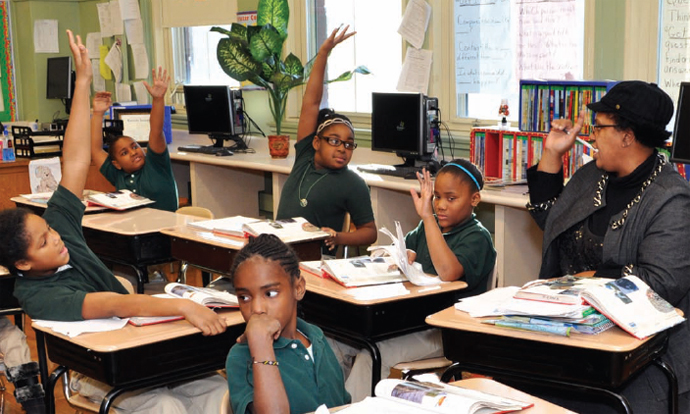
While these lessons were being learned, the San Miguel team opened its second Catalyst charter school, at Austin Circle Rock, in 2007. Perhaps it was just luck that Sala Sims, a seven-year veteran of CPS classrooms, applied for the job of principal. “I knew I wanted to start a school,” she recalls. The Chicago native met Brothers Mike and Ed in early 2007 “and never looked back.”
“She gets it,” says Brother Mike Fehrenbach.
And it showed. After just two years, Austin Circle Rock had an air of order that eluded Howland after three. From the front desk to the back offices and faculty lunchrooms, students and adults at Austin Circle Rock were both more relaxed and more disciplined. And the test scores proved it.
In 2009, Austin Circle Rock students outperformed the other Austin neighborhood schools on the composite (reading, math, and science combined) Illinois Standards Assessment Test (ISAT), with from 68 to 76 percent of students in grades 4 through 8 meeting or exceeding the state standard.
“It’s part of the Resurrection before our very eyes,” says Brother Ed Siderewicz.

How was Howland doing on its test scores?
“Flat would be generous,” says Hannon. In fact, Howland ISAT scores in 2009, with just 49.8 percent of its students meeting or exceeding the state standard, tied for last place among five public schools in North Lawndale.
How could the “formula for success” have gone so far wrong in Howland?
In many respects, it is as simple as what Donnell Harrison, the safety manager at Austin Circle Rock, calls, “following the model.” Donnell has manned the front desk at Austin since it opened. “At Howland they’re conforming to the community instead of to the model.”
This point has not been lost on Catalyst leaders, especially as they work on turning Howland around.
With Hannon as the new Catalyst CEO came a new principal, Chaun Johnson, and the two have become a veritable tag team. Johnson grew up in the Austin neighborhood, where Circle Rock is located and where his wife Natalie now teaches, and he attended Our Lady of Lourdes Catholic School (now closed) in Lawndale. Johnson is articulate, self-assured, and, at over six feet tall, a commanding presence in a room full of teachers and students. (The photograph on page 40 shows him leading the “principal’s choir.”)
“This is a community of potential,” Johnson says. “It would appear that nothing can grow here. I’m here to change that.”
And it would appear, at the beginning of his second year, that he has done that.
Fehrenbach noticed the change “just after Christmas,” he says. “The tone shifted radically. Kids in the classrooms were actually smiling; there was less shouting.”
There is an air of discipline—in the old sense of the word, order—in the school that had not been there the previous two years. All children are now wearing uniforms with shirts tucked in. Test scores have improved markedly. Among Chicago’s 91 charters, Howland showed the fourth-best improvement on ISAT composite test scores in 2010, jumping from a 49.8 percent to a 60.8 percent passing rate.
With Hannon’s help, Johnson began conducting weekly teacher and staff training sessions. They brought in a curriculum instructor, and he brought in trainers for grade-level teacher meetings. The eventual goal, says Hannon, is to send teachers to a Lasallian Leadership Institute. Run by the Christian Brothers and named for the founder of the order, these three-year programs, including a one-week intensive training session during the summer and several weekend sessions, are meant to introduce teachers and administrators to the Lasallian mission and show them how to implement it in their classrooms and schools.
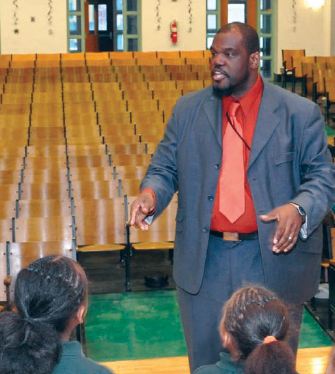
Though the church/state question will no doubt live on, for now the leaders of the Catalyst charter experiment are convinced that the essence of their San Miguel schools can work in a public school setting. “We will live the values and virtues of the Christian Brothers without speaking the words,” says Chaun Johnson. “And that will open the doors so that our education plan can work.”
Johnson represents what it is that the Catalyst backers believe is the point of their charter: they bring a Catholic ethos, not the catechism, to children. And they educate them in reading, writing, and ’rithmetic.
While admitting that Howland still has challenges, Catalyst leaders believe they have turned the corner. And they have learned some hard lessons.
First, they did inadequate relationship building in the community. As many of those involved in the early discussions with the city have said, the Christian Brothers were “naive” or “stupid” to have taken on the Howland project before getting to know the neighborhood.
“A second mistake was starting Howland with grades 4 and 5,” says Ed Siderewicz. Taking on older kids, the brothers now know, requires the kind of knowledge of and relationships with a community that they did not have in North Lawndale.
Third, leadership and staff must understand the model. “Reforming the academic leadership team was our biggest challenge,” says Hannon.
And finally, “we worried too much about the church/state issue,” says Terry Toth. “We run a public school. We don’t have crucifixes on the wall. We don’t teach religion. We teach truth and honesty.”
Is there any one ingredient of success in these matters?
Says North Lawndale College Prep charter school’s John Horan, “You have to have a community of full-grown adults who understand the culture piece and the academic expectation piece. The kids will come around.”
“Hard work,” adds Hannon, who has all but lived at Howland for the last year and shows no signs of slowing down.
And Terry Toth remains bullish on Catalyst’s future. “We’re working on a strategic plan,” he says. “We’re trying to button down the academics and get more consistency there. We’ve taken faith-based and made it values-based. We’re even exploring opportunities to add more schools. The Circle Rock campus got more traction because of Rock of Our Salvation Baptist church and there was community support. So, we’ll be looking for similar things as we expand: a pastor, a supportive community, etc. We’ve learned that you can’t just plop a school down in a neighborhood and expect it to work.”
Brother Mike Fehrenbach would agree. “Be good citizens,” he told a Circle Rock graduation class. “We pledge to stand by you. Failure is not an option.”
Peter Meyer, former news editor at Life Magazine, is currently senior policy fellow with the Thomas B. Fordham Institute and contributing editor at Education Next.
Additional photographs of the Catalyst Schools are available here.


